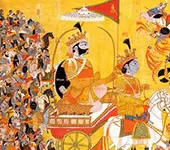History Of Varanasi
Discover the rich history of Varanasi, India's spiritual capital, through the ages. This book takes you on a journey through the city's evolution.
Click here to read PDF Book
Recommended for you
The Practice of Bhojana Sadhana

Embrace Bhojana Sadhana's 19 rules to nourish body and soul, fostering spiritual growth through mindful eating practices....
Click here to know more..Uttanka persuades Janamejaya to conduct Sarpa yajna
 Click here to know more..
Click here to know more..
Swaminatha Stotram

shreesvaaminaatham suravri'ndavandyam bhoolokabhaktaan paripaalayantam. shreesahyajaateeranivaasinam tam vande guham tam gururoopinam nah'. shreesvaam....
Click here to know more..Excerpt
Excerpt
THE KINGDOM OF KASHI AND
THE CITY OF VARANASI
Even though for the last several centuries the two names Kashi and Varanasi have been used for the city and have been fully exchangeable yet in the hoary past they represented. different entities. Then Kashi was the name of the Kingdom and Varanasi was its Capital. In the Atharva Veda Samhita Kashi did not refer to the city and even the Mahabharata mentions two Janapadas- Kasheya and Apar Kasheya. In the Maha Janapada age Kashi was the name of the Janapada and Varanasi was its Capital (Cambridge History of India). In those days. Koshal Janapada was in the North, Magadha in the East, and Vatsa in the West of Kashi Janapada. On this strength Dr. Altekar places its eastern and western bound- aries at Ballia and Kanpur respectively. He also presumes that its southern boundaries were somewhere in the Vin- dhyas. Rahul Sankrityayan, however, differs with this view and according to him the extent of the Kashi Janapada practically coincided with that of the present Varanasi Division. Dr. Motichandra seems to agree with the latter view but is of opinion that some portions of the present Gorakhpur Division were also part of the Kashi Janapada in those days.
Be that as it may, there is no disagreement on the point that Varanasi was the Capital of this Janapada at all times.
In regard to the synonymous use of Kashi and Varanasi it may be mentioned that some of the Jatakas do mention Kashipur or Kashinagar occasionally, but generally the city is referred to as Varanasi. By the Seventh century A. D., however, Kashi was being used for the city also as is proved by the use of the term 'Kasbiti Vikhyatam puram' used in Maharaja Prakataditya's stone inscription discovered at Sarnath. It may in this connection be pointed out that centuries before that time an independent Kingdom of Kashi had ceased to exist and it was rapidly changing hands between the Kingdoms of Koshal and Magadha, although the king of Koshal had at one time placed his brother on the throne of Kashi as a gesture of goodwill to the Kashyas.
What were the limits of the Varanasi city in those early days can be partially gleaned from the Jatakas and early Jaina books, the Puranas or earlier Sanskrit sacred books giving absolutely no indication about the city. There the terms Varanasi and Kashi are invariably used to refer to the Dharma-Kshetra concerned, the boundaries of which were well-defined, and they did not always coincide with the boundaries of the city as will be presently seen.
On the strength of material available, supplemented with knowledge gained from archaeological sources, it may be assumed that in the earliest days the city was not very extensive. It is certain that in the days of the Mahabharata the city as well as the Dharma Kshetra extended on both sides of the Varana river as the sacred spots mentioned therein are situated on both sides of the latter. Besides even a casual visit to Sarai Mohana (area to the north-east of Varanasi) will convince anyone that an extensive city existed there in the earliest days, reaching very near Sarnath in the north. Havell believes that this was the Buddhist city, which sprang up in con- sequence of Buddha's associations. (Benares the Sacred City-Havell p. 42). He, however, ignores the evidence of the Mahabharata, which clearly states that the area concerned was central part of the Varanasi Dharmakshetra, and the ruins clearly indicate that it was part of the city too. Besides the name Varanasi itself has been derived from the ancient name of Varana-Varanasi, which is found in the Mahabharat and from which the name of the city situated on its banks was derived as Varanasi. In the second century B. C. the city extended along the banks of the Ganga (vide Patanjali's Mahabhashya). This fact has been corroborated by the excavations near Raj- ghat, where Mauryan and Shunga strata have revealed the existence of the city, which continues till the Gupta period. To the west of the confluence of the Varana and Ganga there is a high plateau on which stood a fort upto the twelfth century A. D. Mauryan pottery is extensively found in these parts and also stone images and idols, which shows that the city was situated from the confluence upto Rajghat quite upto the Gupta period. Later on, the city continued to grow towards the west and south west and in the twelfth century it extended upto near Gaighat- where an old gate still exists and is called Patan Darwaza (Sanskrit Pattana Dwaram) which means the city gate and even today the gate is surmounted by a stone image of Genesha belonging to the ninth century.

English Topics
Spiritual books
Click on any topic to open
- 30 Adhyatma Ramayana - English Translation
- 29 Kathakali - The Dance Of Kerala
- 28 Varanasi Down the Ages: Tracing the Evolution of India's Spiritual Capital
- 27 Vedas With Meaning
- 26 Valmiki Ramayanam
- 25 Sapthagiri - January - 2019
- 24 Vedas On Marriage - Emancipation Of Woman
- 22 Scientific Hindu
- 21 What Is Hinduism?
- 20 Antyeshti - Death Rituals
Please wait while the audio list loads..
30
Ganapathy
Shiva
Hanuman
Devi
Vishnu Sahasranama
Mahabharatam
Practical Wisdom
Yoga Vasishta
Vedas
Rituals
Rare Topics
Devi Mahatmyam
Glory of Venkatesha
Shani Mahatmya
Story of Sri Yantra
Rudram Explained
Atharva Sheersha
Sri Suktam
Kathopanishad
Ramayana
Mystique
Mantra Shastra
Bharat Matha
Bhagavatam
Astrology
Temples
Spiritual books
Purana Stories
Festivals
Sages and Saints

